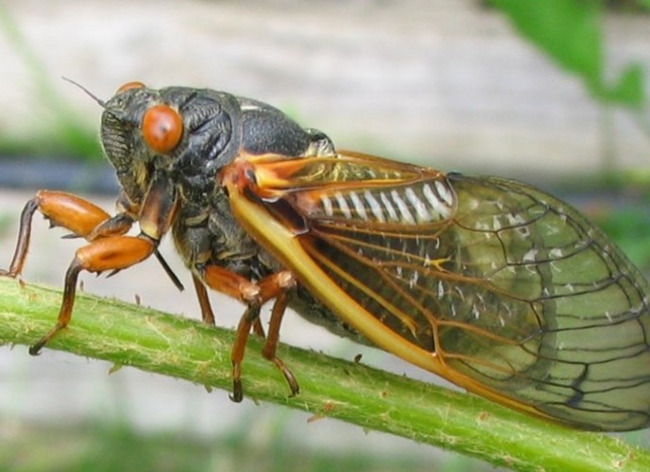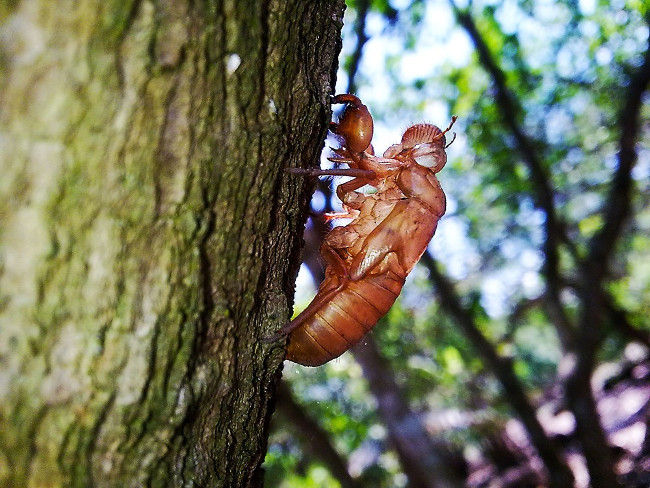Discover supernatural abilities only in cicadas
Cicadas with orchestras clattering on the trees are an integral part of the summer season. But most people do not know that cicadas also have extremely special abilities, 1-0-2 in the insect world.
- List of the most dangerous insects in the world
- Pests can eat plastic, savior of man-made plastic waste
What are those special abilities, we will explore through the article below.

Most ticks have a lifespan of 2 to 5 years.Only a few ticks have a longer life cycle like the Magicicada, which lasts up to 17 years.The larvae of the mites usually live in the soil with a depth of about 30cm to 2.5m and account for most of their life.The cicada's lifespan is very short, lasting only about 40-60 days.This means that the "childhood" of cicadas can last from a few years to 17 years, all buried in the soil and make friends with worms and crickets.

When the larval period ends, the cicada digs a tunnel and crawls to the surface.They then crawled up the trunk and molted into cicadas.The only task of adult cicadas is to find ways to mate to maintain the breed before death.

The cicadas were named mathematicians in the insect world.North American cicadas have a 17-year mating cycle, not at the same time as any other creature on Earth.This helps them not to be prey to enemies because no predators can get used to that cycle to eat them.

Cicadas also know how to change lizard-like "clothes".The red-bellied Huechys sanguinea welcomes the day with a pair of white wings and red body.As the sun rises, their bright red bodies turn red and black and their white wings turn into pure black in just a few minutes.

The cicada's wings possess a matrix of nano-sized blunt spines that can kill all bacteria that attach to it even when it dies.

Cicadas are a great source of protein for humans.The protein content in cicadas is 3.5 times higher than in beef and 6 times higher than in carp.

The cry of African cicadas has a sound intensity of 120bB at close range, higher than the music in the dance hall, about 100dB.
You should read it
- The most unique and beautiful nest eggs in the world of insects
- The easiest ways to get rid of insects in the house
- 3 simple ways to kill indoor insects that are not toxic
- Google accounts for 25% of North American Internet traffic
- New discovery: Dragonfly wings can kill bacteria without antibiotics
- Black face the enemy, the poisonous snake Viper North America must die in a flash
- The towel is the ideal environment for bacteria to grow
- List of the most dangerous insects in the world
May be interested
- Leaving the Avengers aside, these are the 10 most powerful animals in the Marvel universe
 not only characters with human figures, even animals are also transformed into creatures with unimaginable abilities in the universe of marvel.
not only characters with human figures, even animals are also transformed into creatures with unimaginable abilities in the universe of marvel. - Learn about the capabilities of Avenger called Hyperion - the Marvel version of Superman
 in this article we will list the special abilities of hyperion - 'superman' of marvel - from the weakest to the strongest.
in this article we will list the special abilities of hyperion - 'superman' of marvel - from the weakest to the strongest. - Weird human abilities that only 10% of the population can do
 people who can wiggle their ears and raise one eyebrow are completely real. below are some strange abilities that only a few people in the world can do.
people who can wiggle their ears and raise one eyebrow are completely real. below are some strange abilities that only a few people in the world can do. - Top 10 most special people in the world
 looking at the ears, eating everything including metal, metal smoking like magnets ... are especially incredible abilities that not everyone can do.
looking at the ears, eating everything including metal, metal smoking like magnets ... are especially incredible abilities that not everyone can do. - 10 characters have the most powerful ability to heal themselves Marvel, the two 'father' children Wolverine has not reached the top 5
 we will take a look at a few characters with special abilities including healing factor to see which marvel character is the best healer.
we will take a look at a few characters with special abilities including healing factor to see which marvel character is the best healer. - 5 tips to discover new and interesting apps in the iPhone App Store
 the app store contains thousands of great apps that you haven't tried yet. mainstream search terms may not be helpful if you want to discover unique applications and it's not fun to embark on endless scrolling with random keywords.
the app store contains thousands of great apps that you haven't tried yet. mainstream search terms may not be helpful if you want to discover unique applications and it's not fun to embark on endless scrolling with random keywords. - Ability and how to use pets in Coin Master
 abilities and uses of pets in coin master, information about the abilities and uses of pets in coin master, which provides some important attack and defense buffs
abilities and uses of pets in coin master, information about the abilities and uses of pets in coin master, which provides some important attack and defense buffs - Marvel at animals with superhuman abilities that look exactly like Pokemon
 pokemon go is a game phenomenon that is storming the world. however, in wild nature there exist exotic animals possessing superhuman abilities: poisoning, stealth, health ... no less than virtual pokemon creatures.
pokemon go is a game phenomenon that is storming the world. however, in wild nature there exist exotic animals possessing superhuman abilities: poisoning, stealth, health ... no less than virtual pokemon creatures. - The battery, super athlete, eagle's eyes ... 15 'mutants' possess super powers of 'superhuman'
 seeing objects 1.6 km away, slashing a bullet fired at 320km / h, mastering 58 languages, holding breath underwater for 22 minutes ... are incredible incredible abilities of my children people.
seeing objects 1.6 km away, slashing a bullet fired at 320km / h, mastering 58 languages, holding breath underwater for 22 minutes ... are incredible incredible abilities of my children people. - Marvel at red-blooded animals in Vietnam
 the red-bellied cicadas, from the time they were larvae, were all red like a chilli.
the red-bellied cicadas, from the time they were larvae, were all red like a chilli.










 What animal is the biggest crybaby in Earth
What animal is the biggest crybaby in Earth Shivered to see the cobra writhing up and spitting out plastic bottles in India
Shivered to see the cobra writhing up and spitting out plastic bottles in India Fish have nostrils and mouths but are not present
Fish have nostrils and mouths but are not present Whoever expected the creature to be 10cm long and only known on this table could change the world
Whoever expected the creature to be 10cm long and only known on this table could change the world Today, the hot sun in Hanoi reached a record of 41 degrees Celsius
Today, the hot sun in Hanoi reached a record of 41 degrees Celsius Decode the secrets of the dragon faucet, scary natural phenomenon
Decode the secrets of the dragon faucet, scary natural phenomenon